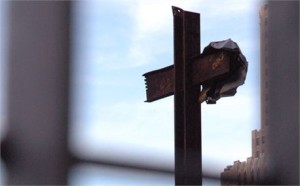 NEW YORK — The Second Circuit Court of Appeals heard arguments on Thursday both for and against a cross-shaped beam that is set to stand on display at the 9/11 museum in New York City, an artifact that was removed from the rubble of the 2001 attack on the World Trade Center.
NEW YORK — The Second Circuit Court of Appeals heard arguments on Thursday both for and against a cross-shaped beam that is set to stand on display at the 9/11 museum in New York City, an artifact that was removed from the rubble of the 2001 attack on the World Trade Center.
As previously reported, the group American Atheists filed a lawsuit against the presence of the cross in 2011, asserting that it has caused individuals to suffer “depression, headaches, anxiety, and mental pain and anguish,” and even indigestion. It had filed suit against numerous responsible parties, including the Port Authority of New York and New Jersey, the World Trade Center Memorial Foundation and New York City Mayor Michael Bloomberg.
“This shrine is a cross. It was picked up, trimmed, polished, the word ‘Jesus’ was carved on top of it, it was prayed over in front of a church for five years, and then it was installed in the WTC memorial with no warning by a priest in a religious service where in the ground was consecrated,” stated David Silverman, the president of the organization. “This is a working Christian shrine in the memorial, and then they had the gall to say it’s not religious in nature, that it represents everybody. That’s not true. It does not represent Jews, Muslims, Mormons or atheists, and they all had deaths on 9/11.”
He also claimed that the cross was problematic because it was stationed on public land.
In March of last year, U.S. District Court Judge Deborah Batts, appointed by Bill Clinton, rejected the arguments of American Atheists regarding its belief that “the government enshrinement of the cross” excluded non-Christians from being recognized in the tragedy. She dismissed the group’s lawsuit, stating that the cross served both a “historic and secular purpose.”
“No reasonable observer would view the artifact as endorsing Christianity,” Batts wrote. “[The museum curators] have not advanced religion impermissibly, and the cross does not create excessive entanglement between the state and religion.”
The organization then appealed to the Second Circuit Court of Appeals, which heard arguments on Thursday from both sides. According to the Washington Post, attorney Edwin Kagin told the three-judge panel that the cross should be removed from the museum, but also proposed that a plaque be allowed in the museum with an inscription noting that “atheists died here, too.”
The panel appeared confused at first regarding what the group actually wanted from the court, but followed with a number of questions to obtain clarity regarding the atheists’ concerns.
“[The cross] violates the First Amendment because atheists are not represented equally,” Kagin said.
Museum president Joseph Daniels, who supports the inclusion of the cross, said that eliminating the display would equate to erasing part of the nation’s history.
“To have a piece of the history that provided some spirituality, some faith, some respite in the midst of all this, if we didn’t have that we really wouldn’t be telling the story as it happened,” he told reporters.
Eric Baxter of the Becket Fund for Religious Liberty agreed. He wrote in a recent piece in the New York Post that “[s]eparation of church and state is one thing, [and] separation of religion and history [is] quite another.”
“The absurdity is obvious. We are not injured, but enriched, by remembering history as it actually happened, religion and all,” he said. “The Second Circuit would be wise not only to find no violation of the Establishment Clause in this case, but no right to sue in the first place.”
Become a Christian News Network Supporter...


